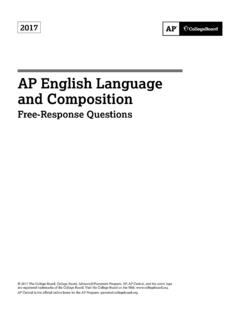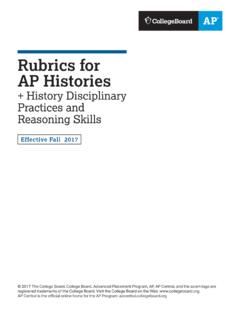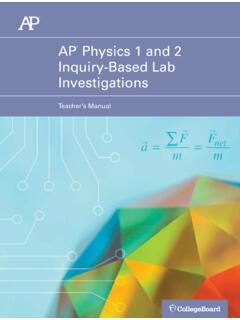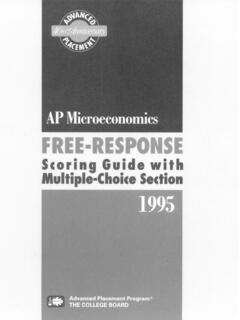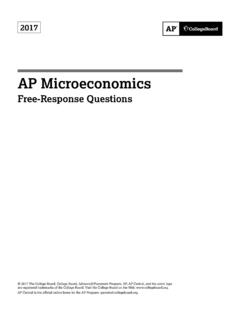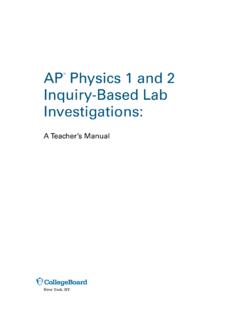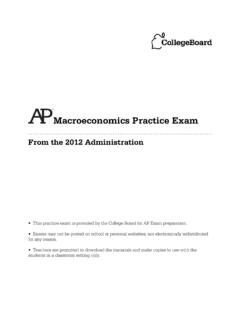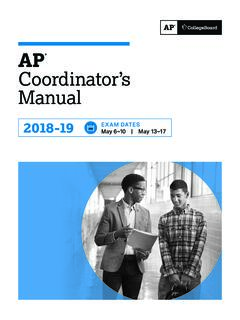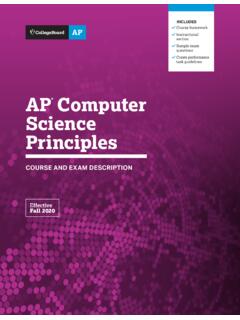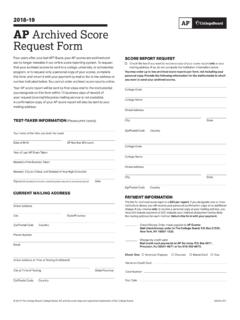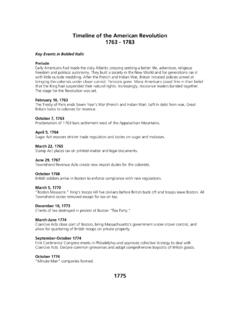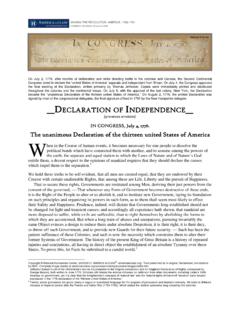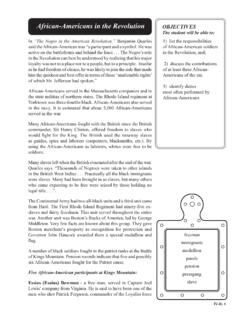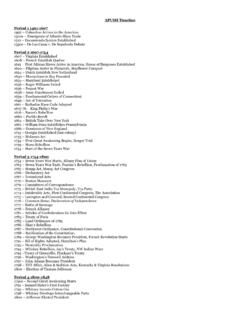Transcription of AP United States History
1 2019AP United States HistorySample Student Responses and Scoring Commentary 2019 The College Board. College Board, Advanced Placement, AP, AP Central, and the acorn logo are registered trademarks of the College Board. Visit the College Board on the web: Central is the official online home for the AP Program: : Long Essay Question 2 RScoring Guideline RStudent Samples RScoring Commentary AP United States History 2019 SCORING GUIDELINES 2019 The College Board. Visit the College Board on the web: Question 2 Long Essay Question Evaluate the extent to which ideas of self-government influenced American colonial reaction to British imperial authority in the period from 1754 to 1776. Maximum Possible Points: 6 Points Rubric Notes A: Thesis/Claim (0 1) Thesis/Claim: Responds to the prompt with a historically defensible thesis/claim that establishes a line of reasoning.
2 (1 point) To earn this point, the thesis must make a claim that responds to the prompt rather than restating or rephrasing the prompt. The thesis must consist of one or more sentences located in one place, either in the introduction or the conclusion. The thesis must make a historically defensible claim that establishes a line of reasoning about how ideas of self-government influenced American colonial reaction to British imperial authority from 1754 to 1776. Examples that earn this point include: Although these taxes are considered to be the reasoning behind the American Revolution, the impending war was more so about the need for individual freedom and republican government that the British deprived them of after the end to salutary neglect.
3 During the era of the Enlightenment, colonists clung to these ideas of Republicanism and self-government and used them to justify opposition to Britain s economic control and political control of the colonies. B: Contextualization (0 1) Contextualization: Describes a broader historical context relevant to the prompt. (1 point) To earn this point, the response must relate the topic of the prompt to broader historical events, developments, or processes that occur before, during, or continue after the time frame of the question. This point is not awarded for merely a phrase or a reference. To earn the point, the response must accurately describe a context relevant to how ideas of self-government influenced American colonial reaction to British imperial authority in the period from 1754 to 1776.
4 Examples of context might include the following, with appropriate elaboration: Mayflower Compact and/or acknowledgment of first chartered colonies Enlightenment ideas about liberty and consent in government Colonial experience with local control of religious institutions ( , Congregationalist church) Salutary neglect / Limited enforcement of the Navigation Acts (1651, 1660, and 1663) AP United States History 2019 SCORING GUIDELINES 2019 The College Board. Visit the College Board on the web: Question 2 Long Essay Question (continued) C: Evidence (0 2) Evidence: Provides specific examples of evidence relevant to the topic of the prompt. (1 point) To earn the first point, the response must identify specific historical examples of evidence relevant to the topic of the prompt.
5 OR Supports an Argument: Supports an argument in response to the prompt using specific and relevant examples of evidence. (2 points) To earn the second point, the response must use specific historical evidence to support an argument in response to the prompt. Examples of evidence used might include: Virginia House of Burgesses Mayflower Compact Albany Congress (1754) Seven Years War (French and Indian War), 1754 1763 Pontiac s Rebellion (1763) Royal Proclamation of 1763 Virtual representation Sons of Liberty (Massachusetts) Nonimportation/nonconsumption Quartering Act (1765) Vice admiralty courts Stamp Act and protests (1765 1766) Stamp Act Congress No taxation without representation Townshend Act (1767) boston massacre (1770) Tea Act (1773) boston Tea Party (1773) Coercive/Intolerable Acts (1773) First and Second Continental Congress Olive Branch Petition (1775) Thomas Paine, Common Sense (1776) Declaration of Independence (1776)
6 AP United States History 2019 SCORING GUIDELINES 2019 The College Board. Visit the College Board on the web: Question 2 Long Essay Question (continued) D: Analysis and Reasoning (0 2) Historical Reasoning: Uses historical reasoning ( , comparison, causation, continuity and change over time) to frame or structure an argument that addresses the prompt. (1 point) To earn the first point, the response must demonstrate the use of historical reasoning to frame or structure an argument, although the reasoning might be uneven or imbalanced. OR Complexity: Demonstrates a complex understanding of the historical development that is the focus of the prompt, using evidence to corroborate, qualify, or modify an argument that addresses the question.
7 (2 points) To earn the second point, the response must demonstrate a complex understanding. This can be accomplished in a variety of ways, such as: Explaining a nuance of an issue by analyzing multiple variables Explaining both similarity and difference, or explaining both continuity and change, or explaining multiple causes, or explaining both causes and effects Explaining relevant and insightful connections within and across periods Confirming the validity of an argument by corroborating multiple perspectives across themes Qualifying or modifying an argument by considering diverse or alternative views or evidence This understanding must be part of the argument, not merely a phrase or reference. Examples of using historical reasoning to frame or structure an argument might include: Explaining how particular ideas from the Enlightenment helped cause American resistance to British rule, such as the Stamp Act protests or the boston Tea Party Tracing the continuity of earlier institutions of self-government such as the Virginia House of Burgesses to the role of local governing bodies in colonial protests, such as committees of correspondence OR Ways of demonstrating a complex understanding of this prompt might include the following.
8 Explaining a nuance of an issue by analyzing multiple variables by, for example, assessing how ideas of self-government played out in different colonies, such as Virginia and Massachusetts Explaining multiple causes of American resistance to British colonial authority, such as the development of a unique American identity Explaining relevant and insightful connections within and across periods by, for example, making comparisons with arguments over federalism in the 1780s and 1790s or States rights in the 1850s or 1960s Confirming the validity of an argument by corroborating multiple perspectives across themes by, for example, exploring cultural ideas about British American exceptionalism or the socioeconomic differences of British American societies from Great Britain Qualifying or modifying an argument by considering diverse or alternative views or evidence by, for example, examining the reasons why colonial resistance against the Navigation Acts before the 1760s was limited compared to the colonial reaction to British imperial authority after 1763 If response is completely blank, enter - - for all four score categories: A, B, C, and D.
9 AP United States History 2019 SCORING GUIDELINES 2019 The College Board. Visit the College Board on the web: Question 2 Long Essay Question (continued) Scoring Notes Introductory notes: Except where otherwise noted, each point of these rubrics is earned independently, , a student could earn a point for evidence without earning a point for thesis/claim. Accuracy: The components of these rubrics require that students demonstrate historically defensible content knowledge. Given the timed nature of the exam, essays may contain errors that do not detract from their overall quality, as long as the historical content used to advance the argument is accurate. Clarity: Exam essays should be considered first drafts and thus may contain grammatical errors.
10 Those errors will not be counted against a student unless they obscure the successful demonstration of the content knowledge, skills, and practices described below. Note: Student samples are quoted verbatim and may contain grammatical errors. A. Thesis/Claim (0 1 point) Responses earn 1 point by responding to the prompt with a historically defensible claim that establishes a line of reasoning about the topic. To earn this point, the thesis must make a claim that responds to the prompt rather than simply restating or rephrasing the prompt. The thesis must suggest at least one main line of argument development or establish the analytic categories of the argument. The thesis must consist of one or more sentences located in one place, either in the introduction or the conclusion.
